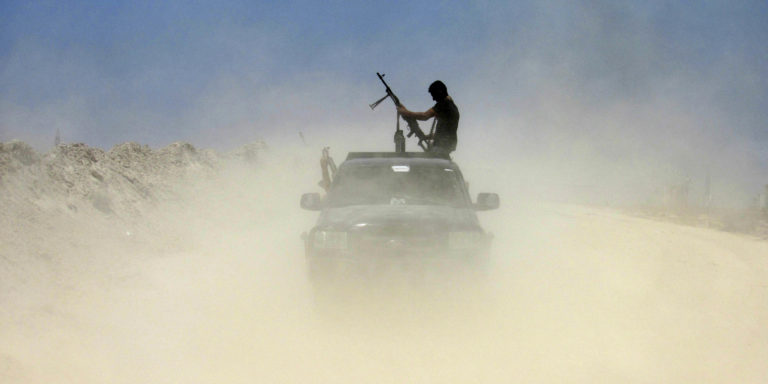INTELBRIEF
February 9, 2021
IntelBrief: The State of Global Terrorism and Counterterrorism

Bottom Line Up Front
- Diminished by law enforcement and military operations and the COVID-19 pandemic, ISIS and Al-Qaeda now act through affiliates in local conflicts.
- The rise of white supremacy and anti-government violent extremism will require greater attention from counterterrorism actors.
- The impact of COVID-19 introduces uncertainty about future attacks; there could be an uptick once restrictions ease and targets are accessible.
- Communities are reeling from the pandemic, with conflict and insecurity proving hospitable motivators for terrorist recruiters and propagandists.
Both the Islamic State and Al-Qaeda are increasingly acting through regional affiliates embedded in local dynamics and conflicts, rather than their centralized operational ‘core.’ Al-Qaeda has “endured a period of high leadership attrition,” notes a recent United Nations report by the team tasked with monitoring the threat posed by these groups. Noting that no country has yet confirmed the death of Aiman Al-Zawahiri, the report confirms the death of Abu Mohamed al-Masri, his deputy, and the arrest of Khalid Batarfi in Yemen – where Al-Qaeda in the Arabian Peninsula (AQAP) was once considered the most dangerous affiliate, and one of the only ones posing a global threat. The strategic direction of the Islamic State in Iraq and Syria (ISIS), the report continues, “has not changed significantly” under the leadership of Muhammad Sa’id Abdal-Rahman al-Mawla.
Although ISIS has lost territorial control, and Al-Qaeda much of its leadership, both retain influence through regional affiliates. In West Africa – Mali, Burkina Faso, the Lake Chad Basin and the Sahel – Islamic State affiliates continue to cooperate and destabilize the region. In Somalia, Al-Qaeda-affiliated al-Shabaab remains responsible for most attacks, even while having to organize responses to the pandemic for communities. The Islamic State in the Greater Sahara (ISGS), for example, maintains effective command and control, notes the UN. The Islamic State in Central Africa Province (ISCAP) continues to use Somalia as a logistical “hub” and conducted its first ever cross-border attack in Tanzania; the group also continue to evolve and conduct attacks in Mozambique, where the group has proved able to conduct simultaneous coordinated attacks. In Afghanistan, where cooperation between the Taliban and Al-Qaeda may be affected by ongoing peace talks, the Islamic State Khorasan Province (IS-K) may be able to peel away hardliners dissatisfied with reconciliation and intent on perpetuating violence. Afghanistan remains the country “worst affected by terrorism in the world,” notes the UN.
All of this is set against the backdrop of a rise in violence instigated by white supremacists, far right extremists, anti-government militias, and conspiracy theorists. This was most dramatically illustrated by the events on January 6, 2021 in Washington, D.C, during the storming of the U.S. Capitol building, but builds on an increased momentum among domestic violent extremist groups and growing transnational connections among white supremacy extremists. Although the insurrection was unsuccessful in attaining its objectives, far-right violent groups have lauded the effort and seen in the attempt the seeds of future successes. Groups like the Russian Imperial Movement have demonstrated the potential for international linkages, as white supremacists and others learn from jihadists by emulating their tactics moving personnel, ideas, and capabilities across borders. While some QAnon conspiracy theorists expressed frustration – even sadness – when their ideas were disproved by the inauguration of President Biden, the widespread circulation of disinformation poses longer term risks. White supremacist groups were already reportedly recruiting among disaffected individuals following the inauguration.
The impact of COVID-19 introduced a number of uncertainties regarding the trajectories of both extreme right-wing violent groups, as well as transnational jihadist groups. In Europe, for example, the past few years have seen more low-tech, low-cost attacks perpetrated by individuals or small groups without direct affiliations with groups like ISIS or Al-Qaeda. This trend continued, with individuals or smaller groups perpetrating attacks in Paris, Dresden, Nice, and Lugano, though the UN reported the attacker in Austria belonged to a group called the “Lions of the Balkans.” With pandemic restrictions limiting movement by operatives and access to targets, large scale attacks are not likely, though this period of relative quiet may provide opportunities for planning and preparing sophisticated attacks when restrictions are lifted. At the same time, with young people increasingly spending more time online, violent extremist groups across the ideological spectrum have further opportunities to spread their narratives, recruit, and mobilize. The widespread disinformation campaigns about COVID-19, 5G technology, and vaccinations may give rise to more violent anti-government movements. Furthermore, we could also see heightened discrimination targeting communities in some way associated with the effects of the pandemic, including healthcare workers or advocates or government proponents of preventive measures. During the early months of the pandemic, in places like New York, for example, Asian-Americans experienced discrimination and xenophobia from those who believed China responsible for the virus; this may dissipate as the virus globalizes but it may heighten tensions between communities in different ways, including between those who do, or don’t, have the possibilities to mitigate its effects.
Nearly two decades after the attacks of September 11, 2001 in the United States, the global terrorist landscape looks more diffuse and diverse, with the centralized core of transnational groups replaced with networks, regional affiliates, and more ideologically diverse violent groups. As communities continue to reel from social, economic, and personal losses due to the pandemic, violent extremist groups can also further exacerbate frustrations with policymakers and practitioners due to inadequate government resources in the face of soaring societal and economic losses from the pandemic. However, counterterrorism officials are not starting with a blank slate – there are over two decades of lessons learned and infrastructure developed. The key imperative will be to ensure these are fit for purpose to address current threats unfolding against a very different geopolitical, social, and economic backdrop.